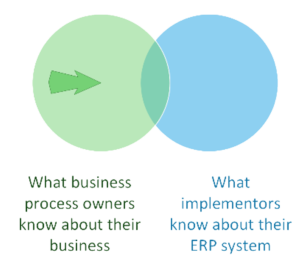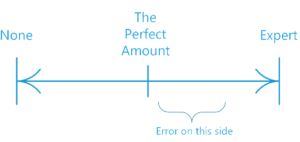When walking through an ERP system process with business process owners, there will likely be areas wher e what the system does and how the business works are not perfectly aligned. If you are an ERP consultant, you have likely seen this before. The business process may need to bend or use another system feature to accomplish the same goal. If you are a business user, you know what you need to run your business, and you’re not inclined to compromise your business for the software. Customers know more about their current processes than ERP consultants, and ERP consultants know how the software should work.
e what the system does and how the business works are not perfectly aligned. If you are an ERP consultant, you have likely seen this before. The business process may need to bend or use another system feature to accomplish the same goal. If you are a business user, you know what you need to run your business, and you’re not inclined to compromise your business for the software. Customers know more about their current processes than ERP consultants, and ERP consultants know how the software should work.
If you are lucky, you will hear, “I don’t understand how this will work for us.” More likely, you will hear that it won’t work. The result of these differing perspectives are modifications to the system that cause cost overruns, compromise the effectiveness of the software, cause quality issues, and must be supported in perpetuity.

The first part of the objection, “I don’t understand,” might be the root cause of the problem, and I think the solution is hidden in plain sight. Before business users believe the system will support their needs, they should fully understand how it works. That may seem obvious, and as an implementor, you likely provided training before digging into finding gaps. But consider whether you provided the right amount of training. There is a continuum between no training and enough training to be an expert. Somewhere between those two poles is the perfect amount of training, and you should err on the side of too much training rather than too little. Training reduces the risk that business users will not have a complete picture.
Here are some common mistakes in training:
Providing training only in navigation and basic concepts, thinking you can train users on functionality while walking them through a business process to find gaps. Understanding the functional intent of the system needs to be addressed separately. Refrain from trying to save time on training, making the project longer and more expensive in the long run.
Demonstrating the system to users once. Few things are truly learned by experiencing them once, and ERP systems follow that rule.
Covering only the material that will be covered in the next requirements session. How a single process fits into the bigger picture is critical. If users only see one piece of a process at a time, it can be hard to see how downstream needs will be met.
Demonstrating the system but not providing hands-on learning. Learning methods vary, and active learning through hands-on use can be a valuable tool.
Not providing realistic data in training. Using data unrelated to the customer’s business can cause more confusion than clarity.
Training takes time, which can be uncomfortable since the budget and schedule are probably constrained. But this is a case of ‘slow down to go fast’ because business users will need to be experts in the system at some point. Increasing their expertise before identifying changes needed will save time over the project’s life and help avoid unnecessary system changes.










